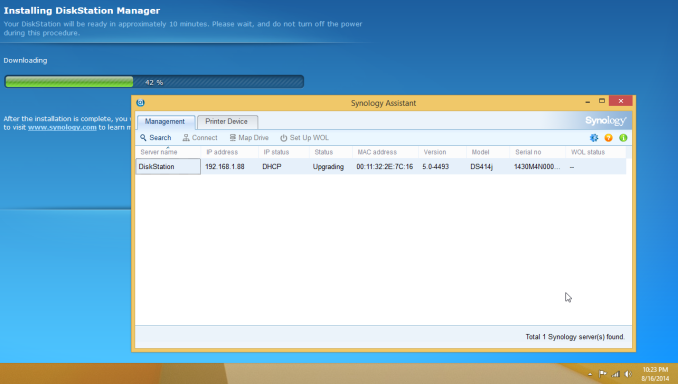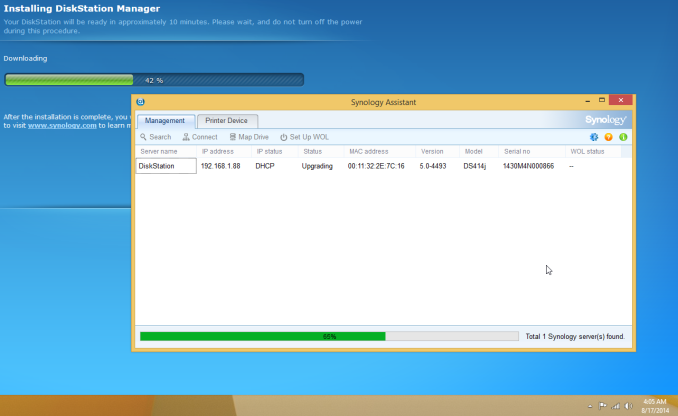Recovering Data from a Failed Synology NAS
by Ganesh T S on August 22, 2014 6:00 AM ESTDS414j Status: Disk Problems or Hardware Failure?
After ensuring the safety of the data, I tried to reinitialize the NAS using the same drives, but the process conked out towards the end with a message indicating that the process was incomplete and telnet service had been enabled for support personnel to look into. Not satisfied with this situation, I rebooted the unit with the drives removed and the reset button at the back pushed in. After the reboot, I inserted two fresh drives and began the initialization process.
DSM Initialization Process 3 Hours After Starting
DSM Initialization Process More than 8 Hours After Starting
The completion process was stuck at 42% with the second drive's LED blinking continuously for more than 48 hours before I pulled the plug. Synology Assistant had shown the status of the unit as 'Upgrading' the whole time.
Synology support asked me to try initializing with a single drive (completely new, fresh out of the box) in another bay. This changed the failure symptom, but didn't resolve the issue.
The unit was shipped back to Synology and they found that one of the circuit board elements had simply died (no burn-out or any other marks). So, it did turn out to be an internal hardware failure in the end. A small percentage of products shipped by any vendor invariably fails in the early stages of being in the consumer's hands. It was just unfortunate for Synology that it happened to a review unit sampled to the press.













55 Comments
View All Comments
Filiprino - Monday, August 25, 2014 - link
Well, if you have a service managing a RAID volume, that is, you have the raid volume mounted, obviously you have to first unmount it, so you have to stop the daemon...Synology's FAQ assumes that the RAID volume is not mounted and that no daemon has interacted with the RAID device first.
So I would not recommend Windows either. And probably you can get by with more complicated cases with Ubuntu than with Windows and UFS explorer.
Anyways, I'd use a GNU/Linux box with ZFS which as no write holes.
cyberguyz - Tuesday, August 26, 2014 - link
The best disaster recovery plan is backup, backup, backup. I've lost hundreds of gigabytes of data before so I know how valuable having a solid backup process is.My DS 412+ runs automated backups done to external drives twice a week (rotated on a monthly basis).
batatudo - Tuesday, September 16, 2014 - link
I have the Synology DS211j and last year I have some problem with one of the disk, at that moment I didn't have another disk to replace the failed one, so my priority was to backup the data from the good drive first. so I searched the internet and found a program called "File Scavenger 4.2" for windows, I was able to recover the data using that program, everything was very easy, I think that program is very similar to USB Explorer, is good to know we have several options to restore the data. After that event I also attached two external USB drive to my NAS and started making backups daily and weekly. Also I'm backing up the most important forlders to Amazon S3, is very cheap and best of all, you can access your data even through Internet Explorer or any other Amazon S3 client. Remember to make at least 3 backups, and one of them must be online or in another physical location.Midav - Thursday, June 16, 2016 - link
Only one month ago i had said just the same: I Have A RAID So My Data Is Backed Up. So i'm knowing about this topic almost evething now. This text is good, there are the most common RAID in it, but i can to advise the blog hetmanrecovery (com). Hetman Software real helped me with Data Recovery, and if you beginner in these questions, it'll help you too.mmuu296 - Sunday, January 21, 2018 - link
it is so interesting!!!!